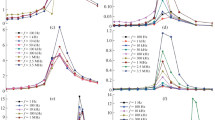Abstract
Temperature dynamics of the dielectric spectra and domain structure in the triglycine sulfate (TGS) hydrogen-containing ferroelectric under heating and cooling has been studied using the dielectric spectroscopy and atomic-force microscopy methods. The dielectric spectra are analyzed by the temperature-frequency dependences of the losses ε″ and by the temperature behavior of the maximum losses ε″max in the dispersion region at frequencies ranging from 102 to 106 Hz. A dynamic conductivity model is proposed for calculating temperature dependences of losses ε″max. The domain structure dynamics during the heating and cooling of the TGS crystal near the phase transition is studied using the in situ piezoresponse force microscopy. It is experimentally and theoretically shown that the relaxation dispersion is governed by the binding of strongly correlated dipoles with the main lattice that serves as a thermostat.
Similar content being viewed by others
References
G.I. Ovchinnikova, N.V. Belugina, R.V. Gainutdinov, E.S. Ivanova, V.V. Grebenev, A.K. Lashkova, and A.L. Tolstikhina, “Temperature Dynamics of Triglycine Sulfate Domain Structure According to Atomic Force Microscopy and Dielectric Spectroscopy Data,” Phys. Solid State. 58(11), 2244 (2016).
C.P. Ganea, C. Mindru, N. Vineticu, and H.V. Alexandru, “Dielectric Spectroscopy in Para-Ferro Transition of TGS,” Ferroelectric. 493, 165 (2016).
A.M. Lotonov, V.K. Novik, and N.D. Gavrilova, “On Dielectric Permittivity Dispersion in Ferroelectric Triglycine Sulfate (TGS) in Wide Temperature Range,” Moscow Univ. Phys. Bull. 61(5), 27 (2006).
R.R. Nigmatullin, “What is Dielectric Spectroscopy? It Is Spectroscopy of Collective Motion,” Georesursy. 2(17), 7 (2005) [in Russian].
V.V. Gladkii, V.A. Kirikov, and E.S. Ivanova, “Slow Relaxation of a Polydomain Ferroelectric inWeak Electric Fields,” Phys. Solid State. 39(2), 308 (1997).
A.L. Tolstikhina, N.V. Belugina, and R.V. Gainutdinov, “Application of the Fourier Transforms for Analysis of the Domain Structure Images of Uniaxial Ferroelectric,” Crystallogr. Rep. 62(3), 464 (2017).
A.A. Potapov, Orientational Polarization. Search for Optimum Models (Nauka, Novosibirsk, 2000) [in Russian].
A.A. Volkov, G.V. Kozlov, S.P. Lebedev, and A.C. Rakitin, “Phenomenological Model of Dynamic Conductivity of Superionic Conductors,” Sov. Phys.-Solid State. 32(2), 329 (1990).
G.I. Ovchinnikova, A.P. Eremeev, and I. Yu. Polyakova, “Temperature Transformation of Microwave Dielectric Spectra of Rochelle Salt in the Dynamic Conductance Model,” Phys. Wave Phenom. 24(1), 48 (2016) [DOI: 10.3103/S1541308X16010106].
Author information
Authors and Affiliations
Corresponding author
About this article
Cite this article
Ovchinnikova, G.I., Eremeev, A.P., Belugina, N.V. et al. Dielectric losses in the triglycine sulfate crystal under heating and cooling. Phys. Wave Phen. 25, 231–237 (2017). https://doi.org/10.3103/S1541308X17030116
Received:
Published:
Issue Date:
DOI: https://doi.org/10.3103/S1541308X17030116



